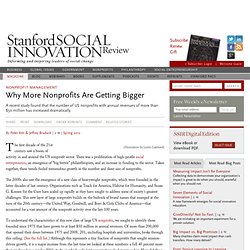

Texas Connector - OneStar Foundation. Five myths about charitable giving. It’s also astonishingly easy to start a charity.

The Internal Revenue Service approves more than 99.5 percent of charitable applications, often in very short order. Because of this, the sector includes more than a few organizations that have little connection to common notions of doing good: the Sugar Bowl, the U.S. Golf Association, the Renegade Roller Derby team in Bend, Ore., and the All Colorado Beer Festival, just to name a few. 2. Donors should reward charities that have low overhead. The notion that charities should put as much money as possible into services and as little as possible into overhead expenses is widely accepted.
Low overhead has become a point of pride — and marketing — for charities such as the Brother’s Brother Foundation, a Pittsburgh-based relief organization whose Web site boasts that “less than 1% of the value of donations [is] used for overhead.” That lack of investment is partly due to public pressure, rather than a shortage of funding. 3. 4. Just graduated? How to make the most of your new, boring corporate job. After a year as an economist with a government agency — a job I enjoyed — I decided to join the portfolio management division at a global investment bank.

The job paid very well, made my parents happy, and put a bold-faced name on my resume. But more often than not, I was miserable. I worked 60-hour weeks and ate more lunches, dinners and late-night snacks at my desk than I’d care to remember. I’d arrive and leave work in the dark, and everything in between was endless spreadsheets and flashing green and red terminals. It didn’t take long before any creative impulse was wiped out by standard operating procedures and endless compliance measures. Making matters worse, I received little feedback about my performance, got few opportunities to expand my skills, and found most of my colleagues to be uninterested in little more than making money. I took the job because, like many people, I was a box checker. But I could have gotten far more out of the experience. More from On Leadership:
Bridge Building or Trust Busting: A Warts-and-All Reflection on “Learning in Public”? Why More Nonprofits Are Getting Bigger. A recent study found that the number of US nonprofits with annual revenues of more than $50 million has increased dramatically.

(Illustration by Justin Gabbard) The first decade of the 21st century saw a boom of activity in and around the US nonprofit sector. There was a proliferation of high-profile social entrepreneurs, an emergence of “big bettor” philanthropists, and an increase in funding to the sector. Taken together, these trends fueled tremendous growth in the number and sheer size of nonprofits. The 2000s also saw the emergence of a new class of heavyweight nonprofits, which were founded in the latter decades of last century.
To understand the characteristics of this new class of large US nonprofits, we sought to identify those founded since 1975 that have grown to at least $50 million in annual revenues. Single-Engine Growth: The first theme echoes a finding from our earlier study—nonprofits that grow big concentrate their funding efforts rather than diversify them. Students Don’t Delay in Joining the Nonprofit Sector. Boards.
Fundraising. Membership_organizations. Development. Social_media. Performance. Strategy. Advocacy. Programs. Merger. Bylaws. Missions. Accounting. Collaboration.